How much is your service worth? Can you put a number on it?

Over spring break, I, along with four other Boston University participants, had the privilege of going on the Jewish National Fund (JNF)’s Alternative Spring Break (ASB) to Israel. I had heard about the program through Boston University Hillel, and since I am actively involved in community service at Hillel, I was encouraged to go. In order to go on the trip, each participant was obligated to raise $975, which goes directly towards the Blueprint Negev Project, the dream of Israel’s first prime minister, Ben Gurion, of populating the Negev, the desert area of southern Israel. The actual trip was free—anonymous donors funded the $2,500 cost per person of sending us to Israel.
As we sat in a circle at the Caesar Hotel in Jerusalem for one of our final discussions at the end of a long week of hard work, our three staff members, Jenn, Kineret and Larry asked us if we thought the work each of us did over the course of the week was worth $2,500. Before I give you the responses of the group, let me describe the activities that we did.
Over the course of the week, our bus of 45 people ages 18 to 30 spent hours of work in the 90-degree heat each day helping to fulfill Ben Gurion’s dream. While spending most of our time in the Be’er Sheva area (the largest city in the Negev), we managed to weed a field of olive trees, pull up and collect over a ton of beets, paint an apartment complex, build terraces, and so much more. Each day we could visibly see the improvement we had made on the environment around us. Here is the breakdown of each day:
Saturday, March 6/Sunday, March 7:
We boarded the El Al plane at JFK airport at 11:50pm on Saturday, March 6. After a ten hour flight to Ben Gurion airport in Tel Aviv, and then another two hour drive down to the Negev, we finally reached our destination: the Beyachad Guest House in Yerucham, the hostel that would be our home until Thursday. It was 8pm Sunday night by the time we got settled, and we were all exhausted from travel. After a group discussion and icebreaker, it was time to put on our pajamas and hit the sacks—we would be getting up at 6:45am the following morning and almost every morning for the rest of the week.
Monday, March 8:
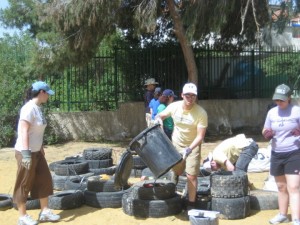
At 7:45am, we were on the bus headed for Be’er Sheva, where we would spend the day working at Earth’s Promise. It was our job to collect garbage and debris that was scattered across the land and use it in the construction of useful things like benches and playthings for children. I personally worked on “the monster,” which was a turtle-shaped plaything that we were building in a park to help entertain children. First we had to collect tires and lie them down on the ground in the shape of the turtle structure. We sloped the tail downward by layering the tires so that it would be like a slide. As for the rest, we alternated single and double tires to give the turtle a bumpy texture fun for children. Once we got the structure down, we tied it all together and stuffed the tires with garbage that we had collected around the park.

We were all very happy to have our work gloves on, a required item on our packing list. As our water bottles lowered and bodies dripped in the heat, we worked all afternoon to fulfill the task at hand. Finally, once all of the tires were stuffed firmly and we had taken a break for lunch (falafel!), it was time to really get down and dirty. We gathered dirt, water, and straw, mixing it together to form mud that we would coat the tires with. Although we did not get a chance to finish the project, we knew that we had worked hard and set a nice foundation for the group that would come the following day. We definitely had our share of fun as well; let’s just say I was covered from head to toe in mud after the mud ball fight I had (and no, I didn’t start it!).
Tuesday, March 9:
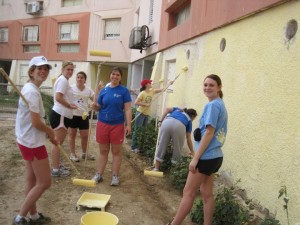
There is no better way to bond than through community service. On our bus ride to the “Dalet” neighborhood in Be’er Sheva, I had already felt like I had made a connection with a lot of people on this trip (even though, for the life of me, I couldn’t remember anyone’s name). As we painted the apartment complex, the teamwork that we had was amazing. By the end of the day, we were able to accomplish so much. We covered so much ground (or…walls, I guess I should say, though the ground did end up with a bunch of spots as well) that we kept running out of paint. Even a couple of the local children playing outside, encouraged by Aaron, one of our bus members, came and helped us out; it was really cute. Simply being
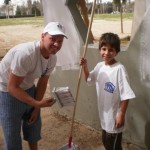
able to interact with the different residents there was an amazing experience (especially when one of them decided to roll my back with a painting roller and then asked to take a picture with me). They couldn’t understand the fact that we came all the way from the United States to volunteer in Israel…that this trip was a vacation for us. In this way, we were stressing to them the importance of community service, and of every individual taking on a role in his or her community. To me, while the painting effort was obviously amazing, I think the most important part of the experience was the personal impact we had on the people living in the community and the interactions we had with them. They just seemed so thankful for what we were doing and amazed at all of the hard work we put in to help them.
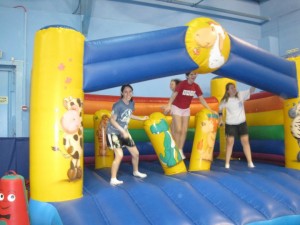
Covered in paint and sweat, we headed from Be’er Sheva to Sderot, a city in the western Negev, where we were able to tour the indoor playground that JNF had recently completed. The significance of this playground was explained to us when we got there: that this was the one place that the children of Sderot could play safely. Due to rocket threats, playing outside was way too dangerous, and the children were stuck in their houses all day with nothing to do. Now, with basketball hoops, air hockey, a climbing wall, video games, and so much more, the children were given a place to have fun and stay safe. In case of rocket threats, this playground is equip with multiple bomb shelters, all within 15 seconds of any play area within the playground, giving the children enough time to hide safely when alerted. This experience gave me a sense of reality—how we take it for granted that we can go outside whenever we want. These are the people we were helping this week—these people who are less fortunate, and don’t have the resources we do.
Wednesday, March 10:
Get ready to man that hoe, because it’s farming time! Yes, the amount of dirty farming jokes were countless today as we worked in an olive field, weeding and pruning row after

row of olive trees. In the heat and beating sun, the hours seemed to go on forever, but it was the funny things like dirty farm jokes that kept us going. We were really beginning to bond as a group, feeling comfortable with one another’s quirky personalities. In the midst of hours of work, someone from our bus who shall not be named (-cough- James) came running out to the field screaming, “Stop drinking the water! It’s chlorinated! You’re all going to pass out and be constipated!” which became the object of much ridicule the rest of the trip—because although people did not believe him and thought he was playing a joke, James really did think the water was chlorinated. While some people were falling asleep in the Bedouin tents, it was due to heat and exhaustion, not chlorinated water. Sorry, James.
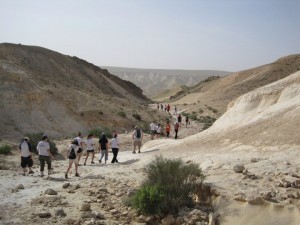
Other things we did today included an hour and a half hike in the morning through the Negev, which was a peaceful time of reflection and great way to begin the day. It was nice, because for the last 20 minutes or so we were asked to remain silent as we walked so that we could really take in our surroundings. Additionally, following the farm we took a trip to Ben Gurion’s grave, which gave us another time to reflect about Ben Gurion and his dreams for Israel.
Thursday, March 11:
The day we had been waiting for—departing the Negev for Jerusalem, the capital of Israel. Although we had enjoyed our stay in Yerucham, we were ready for a little civilization and to have the chance to meet up with friends and family. We spent the morning at Table to Table, where we divided and conquered a field to beets, pulling up and collecting over a ton. We had a nice system going, some people getting the crates and bringing them back, some people picking, and some twisting off the leaves. With our teamwork, we were able to accomplish more than what was expected of us. It may have looked like some of us had committed a murder with all of the beet juice all over us (my once white shirt is now

tie-dyed), but to me, this seemed like the day we really worked the hardest. Watching all of our beet-filled blue crates being stacked and taken away truly gave me a sense of accomplishment. Between yesterday and today, we had saved these farmers more than a month’s work. Over a ton of beets! That’s a lot of beets. It was truly inspiring.
Finally, after a long week, we arrived at the Caesar Hotel in Jerusalem (which was a luxury compared to the hostel in Yerucham) and got a night out on Ben Yehuda, a famous hangout street in Jerusalem with a bunch of bars, shops, and restaurants. It was nice being able to get some downtime to meet up with friends and family in the area and discuss the trip with them. Also, you can’t have a trip to Israel without shopping…10 shekel scarves and earrings. Come on.
Friday, March 12:

And the hoe comes out again. Today we worked in Ein Kerem, another farm area in Jerusalem. We were broken up into multiple groups to do different tasks, such as building terraces, weeding, and passing rocks. My job was to separate and dig out the larger rocks from the dirt, and we made a kind of chain out of it: some of us would dig, pass our full buckets to someone, who would then toss the rocks into another pile and hand the empty bucket back to us. Although I was the victim of a bucket that “accidentally” landed on my head (James!!), it was just another aspect of the trip to laugh about later. Here it was difficult to visibly see the improvements we were making because we were simply setting a foundation for the next group, but we were satisfied by the comments of people who were on the trip the previous year who said they got to see the beautiful end result of their work.
Saturday, March 13:
A day of rest and reflection, and our final day in Israel. This is where I must return to my question from the very beginning of the article: was our work worth $2,500 per person, or would it have been better for the donors to simply donate $2,500 straight to the Blueprint Negev Project? As we sat in a circle, we were asked to think about these questions—what did the trip mean to us? How much of a difference did we make?
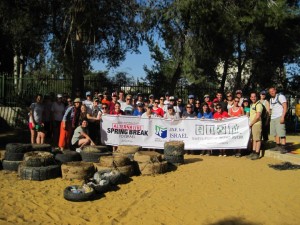
There were many different responses, and the sum total, for the most part, would be this: you cannot simply count the physical work that we had done this trip, but must also factor in the emotional aspect as well. If you are just talking numbers, it is hard to judge if you personally did $2,500 worth of work. What counts also is how the trip affected you and the people around you. I think each of us came out of this trip with a greater respect and understanding for the land of Israel. We all put down our mark on the land and learned a lot from our experience. This is an experience that will be with each of us for the rest of our lives. That is what makes this trip priceless. Not only that, but also the connection we made with the Israeli’s and immigrants on our work sights. We had an impact on the people we talked to and the children we played with. They saw what we were doing, and hopefully learned from our actions. Again, you cannot price relationships like that in a dollar amount.
“I had an amazing experience on the trip and I appreciate all the money that was raised for me so that I could go on the trip. No matter what the cost was I definitely feel that every penny put in was well spent.”
-Sarah B

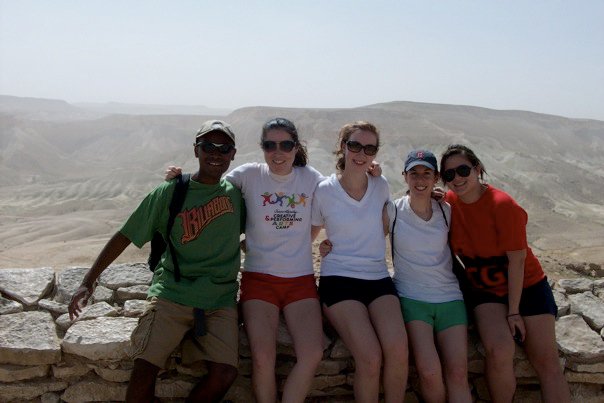
An excellent recount of one of the most meaningful volunteer work projects we embarked on in the Jewish state.
Awesome article, but one key note…Erica can’t get photo credit if she was in the photo, ahem, I believe someone else took that photo, ahem, ahem. 😉 Great Job!